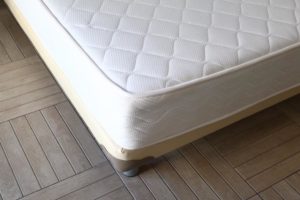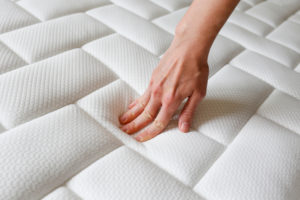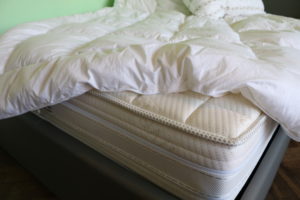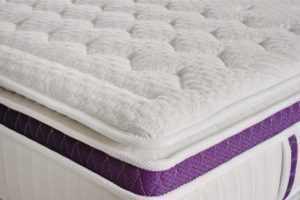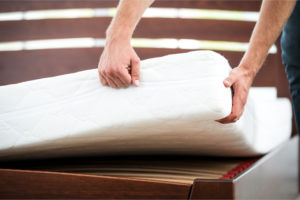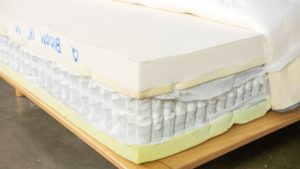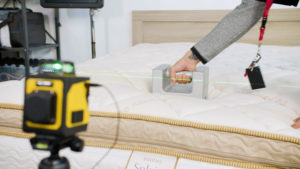How to Store a Mattress: 5 Simple Steps
Whether you’re moving, going on extended travels, or you’ve just bought a new mattress but aren’t ready to part with your old one, you may need to store a mattress. While storing a mattress is fairly simple, there is a right way and wrong way to do it. When stored improperly, a mattress can become damaged and its warranty may even be invalidated.
We’ll walk you through how to correctly store your mattress, whether it’s a latex, foam, or hybrid mattress model. Save yourself trouble in the future by learning how to store a mattress in five simple steps.
Step 1: Prepare the Mattress for Storage
To prepare your mattress for storage, you’ll first need to clean your mattress and then protect the mattress by covering it.
Clean the Mattress
Before beginning to clean your mattress, check the manual or any instructions that came with it to see if there are specific ways the manufacturer recommends cleaning it. Some mattresses have a removable, washable cover, while others should not get wet or can be damaged by certain types of cleaning agents.
To begin cleaning, clear items off your mattress, including bedding like comforters, blankets, and sheets. Check the mattress’ surface and sides for stains. Gently dab any stains with a washcloth that you’ve moistened with water and a mild soap. For tough stains, consider using a stain stick or a stain remover specifically designed to be used on mattresses. Avoid harsh cleansers, including upholstery cleaners. Once the stains are removed, let the spots air dry.
Next, open a box of baking soda and sprinkle a layer of baking soda over the top of the mattress. (If your mattress doesn’t have any stains, begin cleaning by using the baking soda). Let the baking soda sit on the mattress for an hour. Then, vacuum the baking soda up using a hand vacuum or a vacuum with an upholstery attachment.
Finally, flip the mattress over. Repeat the same process on the other side of the mattress. If there are stains, treat them. When the mattress is dry, cover it with baking soda, let the baking soda sit for an hour, then vacuum it up. Once both sides of the mattress have been freshened up, you’re ready to cover your mattress.
Protect the Mattress
Use a mattress cover to completely surround the mattress and protect it from dust, dirt, debris, moisture, and potential pests while it is in storage. To protect your mattress, your best options are to either put it in a mattress bag or cover it on all sides using sheets of plastic.
Mattress bags made specifically for storing or transporting a mattress are relatively low-cost and widely available for purchase from moving companies, hardware stores, and online retailers like Amazon. Mattress bags are available in every mattress size, and they usually have a built-in sealing system to keep the mattress protected. You will likely need two people to put a mattress in a mattress bag — one to hold up one end of the mattress, and the other to slide the bag around it.
If you decide to protect your mattress using sheets of plastic, you will need to wrap the plastic around the mattress, then secure it using duct tape. Begin by spreading the plastic out on the floor, then setting the mattress on top of it. Make sure none of the mattress is left exposed, and none of the duct tape touches the mattress itself. Sheets of plastic are also widely available from hardware stores and online retailers.
Step 2: Choose a Storage Location
Before deciding on a storage location, measure your mattress. Knowing the length, width, and height of your mattress ensures you will be informed as you consider your storage space options. You’ll want to decide if you’re going to lay the mattress flat or upright when storing it before you choose your mattress storage location. Keeping the mattress flat takes up more space, but is best, as this position is least likely to damage the mattress.
Too much moisture, high humidity, and extreme temperatures have the potential to harm your mattress, so it’s best to store your mattress somewhere it can stay safe from environmental hazards. Many people choose to store mattresses in a storage unit, a basement, a garage, and other spaces.
Storage Unit
For many people, the safest place to store a mattress is a storage unit. Ideally, you would use a climate-controlled storage unit to protect your mattress from high humidity and extreme temperatures.
When searching for a storage unit, consider location, size, and price. You want a location you can conveniently access when you need the mattress again. The unit itself should be large enough to store the mattress lying flat and any other items you want to store, without requiring you to set other items on top of the mattress. Finally, the price should make sense given how long you want to store the mattress. For example, it wouldn’t make sense to pay more for mattress storage than you would pay to buy the mattress new.
Basement
A basement can be a good location to store a mattress, as long as it is clean and climate-controlled. A basement that is wet or has high humidity wouldn’t be a good storage space.
Garage
A garage can also be a good storage option for a mattress, depending on its temperature and humidity level. In order for a garage to be a viable mattress storage option, the space should not reach extreme temperatures, allow in rain, or have high humidity.
Other
If a friend or relative is willing to let you store your mattress in their climate-controlled home, that could be an affordable and helpful option. Before agreeing to store your mattress elsewhere, check out the space to make sure it’s the right size. Talk with the homeowner to make sure you are in agreement about how long the mattress will stay there and how it will be stored.
Sometimes people are tempted to store a mattress in a less than ideal location in an attempt to save money. For example, a person may want to store a mattress in a shed, a truck bed, or on a porch. These storage options aren’t the best, because they could expose the mattress to extreme temperatures, moisture, high humidity, dirt, or pests. You may save money on storage, but come back to find your mattress damaged and unusable after a few months.
Step 3: Transport the Mattress Safely
Move your mattress responsibly by finding an option that will keep it protected. The ideal way to move a mattress is to place it in a moving truck that shuts and locks, keeping out rain and dirt.
If you own a large van or a covered truck that allows you to keep it flat, that may be another option for moving your mattress. Avoid moving your mattress by strapping it to the top of a car or putting it in a vehicle that requires it to be folded, rolled, or smashed in order to fit.
If you are also storing a bed frame or platform bed, you may need to disassemble the bed frame prior to moving it. You can then reassemble it in the storage location.
Step 4: Store the Mattress Properly
Although storing a mattress on its side takes up less space, generally, the best option is to store your mattress flat. Certain types of mattresses, particularly latex and all-foam models, can sag and become damaged when left on their side for too long. If possible, store your mattress on top of a bed frame or platform sitting on a level surface.
If you do store a mattress on its side, don’t leave it that way for more than a month. Also, check to see if storing your mattress on its side voids the warranty.
If you’re storing a brand-new mattress that is rolled and in a box, you’ll want to unroll it before storing it. While an unrolled mattress takes up less space, a rolled mattress can become damaged over time. Usually, mattresses in a box are only meant to stay rolled up for one or two months maximum. Leaving them rolled longer may also void the warranty.
Do not store your mattress with anything stacked on top of it. Leaving items on top of the mattress may lead to sagging or indentations over time.
You can purchase a low-cost, battery-operated thermostat to find out the temperature and humidity level of a potential mattress storage space like a basement before deciding whether it’s a good choice for you. If humidity is too high, a small dehumidifier kept near your mattress may help keep it from becoming too moist.
Don’t Void the Warranty!
If your mattress is still under warranty, carefully read the warranty terms before deciding how to store your bed. Some warranties become void if a mattress is stored on its side, laid on the floor, or left in the box it arrived in for an extended amount of time.
Step 5: Maintain the Stored Mattress
Once your mattress is in storage, maintain it by checking in on it every few months. Visit the mattress and open the mattress bag or storage plastic to air it out and check to make sure no damage has occurred. If your mattress’ instructions suggest flipping or rotating the mattress on a certain schedule, maintain that schedule while the mattress is in storage to keep it in ideal condition.

Still have questions? Ask our community!
Join our Sleep Care Community — a trusted hub of sleep health professionals, product specialists, and people just like you. Whether you need expert sleep advice for your insomnia or you’re searching for the perfect mattress, we’ve got you covered. Get personalized guidance from the experts who know sleep best.










